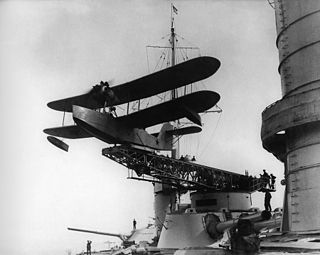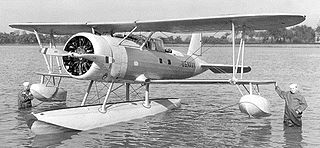
The Heinkel He 115 was a three-seat World War II Luftwaffe seaplane. It was used as a torpedo bomber and performed general seaplane duties, such as reconnaissance and minelaying. The aircraft was powered by two 960 PS BMW 132K nine-cylinder air-cooled radial engines. Some later models could seat four, had different engines or used different weapon arrangements.

The Heinkel He 114 was a sesquiwing reconnaissance seaplane produced for the Kriegsmarine in the 1930s for use from warships. It replaced the company's He 60, but did not remain in service long before being replaced in turn by the Arado Ar 196 as Germany's standard observation seaplane.

The Albatros B.II, was an unarmed German two-seat reconnaissance biplane of the First World War.

The Aichi D1A or Navy Type 94/96 Carrier Bomber was a Japanese carrier-based dive bomber of the 1930s. A single-engine, two-seat biplane based on the Heinkel He 50, the D1A was produced by Aichi for the Imperial Japanese Navy, remaining in service as a trainer at the time of the attack on Pearl Harbor. The D1A was produced in two variants, the D1A1, and the D1A2.

The Heinkel He 45 was a light bomber produced in Germany in the early 1930s, one of the first aircraft adopted by the newly formed Luftwaffe. Its appearance was that of a conventional biplane and included seating for pilot and gunner in tandem, open cockpits. Developed in parallel with the He 46, it appeared in 1931 as a general-purpose biplane and was employed mainly as a trainer, but was also used by the Luftwaffe for reconnaissance and light bombing duties. Production of this plane totalled 512 aircraft, including those built under licence by Gotha, Focke-Wulf, and BFW.

The Douglas O-43 was a monoplane observation aircraft used by the United States Army Air Corps.

The Curtiss Twin JN was an Experimental aircraft built by the Curtiss Aeroplane and Motor Company for the United States Army Air Service. It was a biplane, designed for observation missions.

The Heinkel HD 42 50, later designated the Heinkel He 42 was a German two-seat biplane seaplane originally designed for the Deutsche Verkehrsfliegerschule, and later built for the German Luftwaffe. The aircraft was used until the end of World War II as a trainer for maritime pilots.

The Heinkel HD 22 was a trainer designed in Germany during the 1920s. It was a conventional single-bay biplane with staggered wings braced with N-type interplane struts. The pilot and instructor sat in tandem, open cockpits, and the main units of the fixed, tailskid undercarriage were linked by a cross-axle.

The Heinkel HD 24 was a training seaplane developed in Germany in the late 1920s. It was a conventional single-bay biplane with equal-span, staggered wings. The fuselage was braced to both the upper and lower wings with a number of struts on its sides, in addition to the normal cabane struts. The pilot and instructor sat in tandem, open cockpits, and the undercarriage consisted of twin pontoons, although this could be readily exchanged for wheels or skis.
The Heinkel HD 36 was a trainer developed in Germany in the 1920s at the request of the Swedish Air Force, which was in search of a new trainer aircraft. The newly formed air force had previously evaluated the HD 35, found it to be underpowered, and asked Heinkel to address this problem. Heinkel's response was a development of the HD 35 modified to use the Mercedes D.III engine instead. The HD 36 also dispensed with the third cockpit that had been a feature of the HD 35 and HD 21 before it, but otherwise the design was largely the same. The single example built by Heinkel was tested by the Air Force, and found still not quite satisfactory, was modified by CFM until the problems had been largely eliminated. Once this had happened, CFM built two batches of 10 aircraft, delivering them in 1928 and 1930 as the Sk 6.

The Heinkel HD 37 was a fighter aircraft, designed in Germany in the late 1920s, but produced in the USSR for Soviet Air Force service. It was a compact, single-bay biplane with staggered wings of unequal span, braced by N-type interplane struts. The pilot sat in an open cockpit, and the main units of the tailskid undercarriage were linked by a cross-axle.

The Heinkel HD 39 was a special-purpose cargo aircraft developed in Germany in the 1920s to distribute the Berlin newspaper B.Z.. It was a conventional single-bay biplane with staggered wings of equal span, and a fuselage that nearly filled the interplane gap. The pilot sat in an open cockpit, and the undercarriage was of fixed, tailskid type with divided main units. The sole example of the type was built after Ernst Heinkel found out, by chance, that B.Z. required such an aircraft and had ordered two machines from Albatros. Heinkel convinced publisher Ullstein-Verlag to purchase a third aircraft from his firm.

The Heinkel HD 55 was a biplane flying boat produced in Germany in the early 1930s for use as a reconnaissance aircraft aboard Soviet warships. The design was based on the HD 15 mail plane of 1927 and was a conventional design for its time, with equal span, unstaggered wings, and an engine mounted tractor-wise on struts above the pilot's open cockpit. A second open cockpit was added on the rear fuselage to provide a position for a tail gunner.

The Douglas XO2D-1 was a prototype American observation floatplane of the 1930s. It was a single engined biplane intended to be launched by aircraft catapult from ships of the United States Navy, but only one was built, the production contract going to Curtiss for the SOC Seagull.

The Curtiss Model J was a prototype tractor configuration aircraft that became the basis for the Curtiss Jenny series of aircraft.

The Early Bird Jenny is an American homebuilt aircraft that was designed by Dennis Wiley and produced by the Early Bird Aircraft Company of Erie, Colorado, also by Leading Edge Airfoils of Peyton, Colorado. When it was available the aircraft was supplied as a kit and also in the form of plans for amateur construction.
The Mitsubishi G7M Taizan was a proposed twin-engine long-range bomber designed for use by the Imperial Japanese Navy in 1941.
The Heinkel HD 16 was a single-engine biplane torpedo aircraft developed by the German aviation company Ernst Heinkel Flugzeugwerke in the nineteen-twenties and produced under license by Svenska Aero in Stockholm, Sweden.
The Heinkel HD 19 W was a biplane seaplane fighter developed by Ernst Heinkel Flugzeugwerke.
















